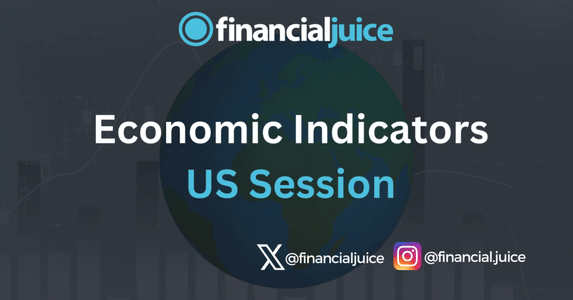
Week Ahead: Economic Indicators (US)
Hey, Traders!
For the April 29th week, here is a list of all of the major economic indicators being released during the US Session, with a brief synopsis of what they represent and what to possibly expect from the markets in reaction.
Tuesday 30th April
08:30 ET
Canadian GDP for February
Gross Domestic Product measures the total value of goods and services produced within a country’s borders over a specific period, typically annually or quarterly.
In the case of Canada, its GDP reflects the sum of consumption, investment, government spending, and net exports.
It serves as a crucial indicator of the country’s economic health and performance, influencing policies and decisions at both national and international levels.
What to Expect
If GDP comes in higher than expected, it could be an upside risk to inflation, however it could also reduce the economies risk of a recession.
10:00 ET
US CB Consumer Confidence for April
The Consumer Confidence Index (CCI) is a measure of how optimistic or pessimistic consumers are about the overall state of the economy and their personal financial situation.
In the United States, the Conference Board conducts monthly surveys to gauge consumer confidence, asking questions about current economic conditions and future expectations.
A higher index value indicates greater confidence, suggesting consumers are more likely to spend, while a lower value implies decreased confidence and potential reduced spending.
The CCI is closely watched by economists, policymakers, and investors as it provides insights into consumer spending trends and overall economic sentiment.
What to Expect
If consumer confidence comes in higher than expected, this could lead to higher consumer spending.
This could be an upside risk to inflation, which could feed into the narrative of ‘higher for longer’ rates.
If realized, the dollar could see some strength, while US stocks could see some weakness.
If it comes in cooler than expected, the opposite could be expected.
Wednesday 1st May
08:15 ET
US ADP Employment Change for April
The ADP Employment Change report provides an estimate of the change in non-farm private employment in the United States, excluding government jobs and farming.
It is released monthly by the ADP Research Institute in collaboration with Moody’s Analytics, using payroll data from a subset of ADP’s clients.
The report serves as an early indicator of the health of the labor market.
What to Expect
If ADP comes in hotter than expected, this would be seen as a strengthening job market.
This could also mean consumers, on average, would have more money to spend.
This could be an upside risk to inflation.
If realized, this could show some strength in the dollar, and weakness in US Stocks.
If ADP comes in cooler than expected, the opposite could also be true.
10:00 ET
US JOLTS Job Openings for March
The Job Openings and Labor Turnover Survey is a monthly report published by the US Bureau of Labor Statistics.
It provides data on job openings, hires, quits, layoffs, and other separations in the US labor market.
Job openings represent the number of available positions that businesses are actively seeking to fill.
The JOLTS report offers insights into the demand for labor, dynamics of the job market, and trends in voluntary and involuntary job separations.
What to Expect
If JOLTS comes in higher than expected, this could mean companies have higher demands for filling vacancies.
This could mean companies are doing well and have demand for more labor, despite higher interest rates.
This could show that companies can handle high rates, this could feed into the ‘higher for longer’ rate narrative.
If realized, the dollar could see some strength, and US stocks could weaken.
The opposite could also be true.
US ISM Manufacturing for April
The ISM Manufacturing PMI, measures the health of the manufacturing sector.
Similar to other PMI indicators, a reading above 50 indicates expansion in the manufacturing sector, while a reading below 50 suggests contraction. The PMI is based on five major survey areas — each of which is weighted equally: New orders, Inventory levels, Production, Supplier deliveries, Employment.
What to Expect
The ISM manufacturing PMI has been in contraction for 16 consecutive straight months and from it’s last data release a further decline didn’t spark any recess fears, however markets took it as a positive indication that the Fed won’t have to hold rates for longer. If the PMI were to follow the same trend and decline again markets may view the data in the exact same way.
10:30 ET
US Weekly EIA Crude Oil Inventories
The US Weekly Energy Information Administration Crude Oil Inventories report provides information on the total stockpile of crude oil in the United States. It includes data on the changes in crude oil inventories, indicating whether there has been an increase or decrease in the amount of oil held in storage. This report is crucial for assessing supply and demand dynamics in the oil market and can influence oil prices.
What to Expect
A significant build-up in inventories may indicate oversupply, putting downward pressure on prices, while a decline may suggest increased demand, potentially impacting prices in the opposite direction.
14:00 ET
US Interest Rate Decision
The US Interest Rate Decision refers to the determinations made by the Federal Reserve, specifically the Federal Open Market Committee (FOMC), regarding the federal funds rate.
The federal funds rate is a key benchmark interest rate influencing short-term borrowing costs throughout the economy.
The FOMC conducts regular meetings to assess economic conditions and adjust monetary policy accordingly. Changes in the interest rate have broad implications, impacting borrowing costs for businesses, consumers, and financial institutions.
A higher rate is often used to cool off an overheating economy, while a lower rate is employed to stimulate economic activity during periods of sluggish growth or recession.
What to Expect
Markets generally expect no change at this rate decision, however, the vocabulary used in the rate statement and press conference often causes the biggest moves as traders hang on every word for forward guidance on the future of moves or what sectors need to do more to help inflation head towards 2%.
More hawkish remarks (implying higher-for-longer rates)
Thursday 2nd May
08:30 ET
US Weekly Initial Jobless Claims
The US Weekly Initial Jobless Claims report provides the number of people who filed for unemployment benefits for the first time during the past week, serving as a measure of new layoffs.
This indicator is a key gauge of the labor market’s health and economic activity, with lower numbers suggesting fewer layoffs and a stronger job market.
Continued Jobless Claims, on the other hand, represent the number of people already receiving unemployment benefits.
This figure helps gauge the longer-term employment situation and provides insight into how easily displaced workers are finding new employment.
Both metrics are monitored by investors, policymakers, and economists because they offer real-time insights into labor market conditions and, by extension, the overall health of the economy.
What to Expect
Higher jobless claims indicate a higher unemployment rate.
This means if Jobless Claims came in higher than expected, it could cause strength in US stocks and weakness in the dollar, as traders increase the chances of rate cuts this year as the labor market calls.
10:00 ET
US Durable Goods March Final
Durable goods refers to goods that have a lifespan extending over three years.
In the United States, the Census Bureau publishes a monthly report called the “Durable Goods Orders” report.
This report tracks the new orders placed with domestic manufacturers for delivery of factory hard goods, such as refrigerators, cars, and industrial machinery, which are expected to last three years or more.
The data in this report is a key economic indicator as it provides insight into the health of the manufacturing sector and overall economic activity.
What to Expect
This release is unlikely to cause a market reaction.
However, any shock deviations from forecast could be negative for stocks and the dollar, as any extreme weakness could foreshadow the manufacturing sector going into free fall.
A much higher reading may show overheating in the sector.
Friday 3rd May
08:30 ET
US Employment Situation for March
US Nonfarm Payrolls for March
US Nonfarm Payrolls, commonly referred to as NFP, is a key economic indicator published by the Bureau of Labor Statistics on a monthly basis.
It represents the total number of paid workers in the US, excluding farm employees, government workers, and non-profit organization employees.
The NFP report provides insights into the overall health of the labor market, reflecting changes in employment levels.
The data is closely watched by policymakers, economists, and investors for its impact on financial markets and economic policy decisions.
US Unemployment Rate
The US Unemployment Rate is a widely tracked economic indicator that measures the percentage of the labor force that is unemployed and actively seeking employment.
It is calculated by dividing the number of unemployed individuals by the total labor force.
The Unemployment Rate can differ from the Nonfarm Payrolls data due to differences in their definitions and methods of measurement.
While NFP represents the total number of paid workers in the US, excluding certain categories like farm and government employees, the Unemployment Rate considers the percentage of the labor force that is actively seeking but unable to find employment.
US Average Earnings YoY
US Average Earnings Year-over-Year is an economic indicator that measures the annual percentage change in the average earnings of all non-farm employees in the United States.
This data is typically derived from the monthly employment reports released by the US Bureau of Labor Statistics.
Average earnings include wages and salaries, and the YoY comparison helps assess the rate of change in workers’ compensation over a one-year period.
Positive growth in Average Earnings YoY is indicative of increasing income levels, while negative growth suggests a decline in average earnings. Policymakers, economists, and investors monitor this indicator for insights into wage trends and their implications for consumer spending and inflation.
What to Expect
The US non-farm payrolls is the most highly monitored employment indicator by both traders and policymakers. A higher-than-expected reading suggests that employment is not slowing, posing an upside risk to inflation.
This may lead the Federal Reserve to maintain interest rates higher for longer, as the FOMC have mentioned that a higher unemployment rate (around 4% according to some officials) is necessary to see inflation fall to the 2% target.
This repricing of the future of US monetary policy may create weakness in US stocks while strengthening the dollar. The inverse could also be true.
Having said that, members will also look at average earnings statistics to see if rising salaries coulse pose the risk of a future wage-price spiral.
09:45 ET
US S&P Services PMI April Final
The US S&P Services Purchasing Managers’ Index is an economic indicator that measures the activity level of purchasing managers in the services sector.
It provides insight into the health and direction of the services industry, which includes sectors like healthcare, retail, finance, and transportation.
As a diffusion indicator, a PMI above 50 indicates expansion in the sector, while below 50 suggests contraction.
It is based on surveys of purchasing managers, reflecting their views on factors like new orders, employment, and business conditions.
What to Expect
Fed officials have noted that the servicesectoris a headwind in bringing inflation back down to target.
This means,if the Service sector continues to strengthen, with the PMI coming in higher than expected,this could feed into the higher for l;longer rate narrative, and cause weakness in US stocks and strength in the dollar.
If it comes in cooler than expected, the opposite is also true, as it could cause traders to push forward bets on rate cuts this year.
10:00 ET
US ISM Services PMI for April
The US Institute for Supply Management Services PMI is another economic indicator that measures the activity level of purchasing managers in the services sector.
Like the S&P Services PMI, it provides insight into the health of the services industry.
However, there are some key differences between the two:
Survey Methodology: The ISM Services PMI is based on a survey of purchasing and supply executives in the United States, while the S&P Services PMI is based on surveys of purchasing managers.
Components: The ISM Services PMI includes various components such as business activity, new orders, employment, and supplier deliveries. These components provide a broader view of the sector’s performance. In contrast, the S&P Services PMI may have a different set of components tailored to its methodology.





